Attached files
| file | filename |
|---|---|
| 8-K - FORM 8-K - Vericel Corp | a54804e8vk.htm |
Exhibit 99.1
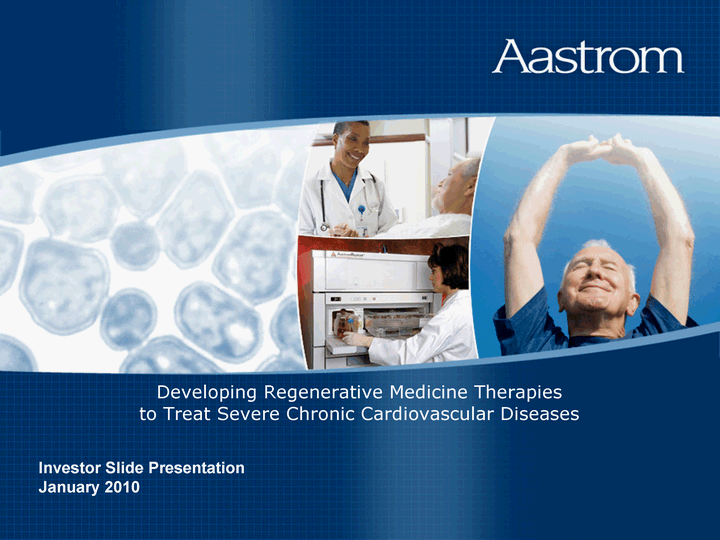
| Investor Slide Presentation January 2010 Developing Regenerative Medicine Therapies to Treat Severe Chronic Cardiovascular Diseases |
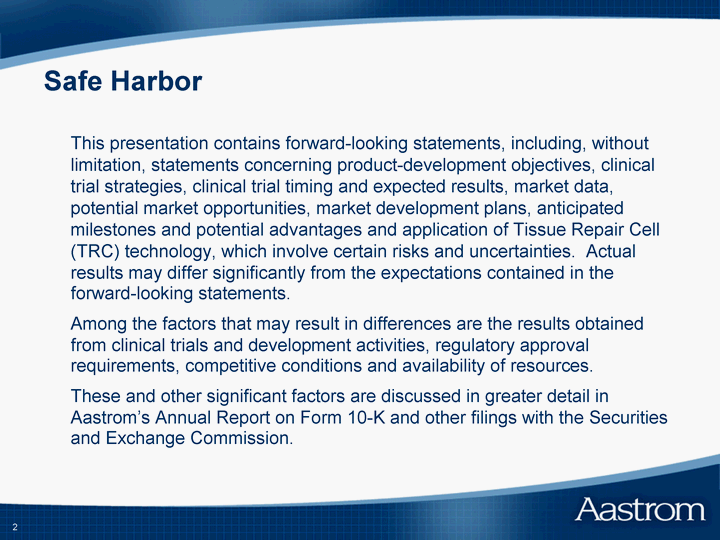
| 2 2 Safe Harbor This presentation contains forward-looking statements, including, without limitation, statements concerning product-development objectives, clinical trial strategies, clinical trial timing and expected results, market data, potential market opportunities, market development plans, anticipated milestones and potential advantages and application of Tissue Repair Cell (TRC) technology, which involve certain risks and uncertainties. Actual results may differ significantly from the expectations contained in the forward-looking statements. Among the factors that may result in differences are the results obtained from clinical trials and development activities, regulatory approval requirements, competitive conditions and availability of resources. These and other significant factors are discussed in greater detail in Aastrom's Annual Report on Form 10-K and other filings with the Securities and Exchange Commission. |
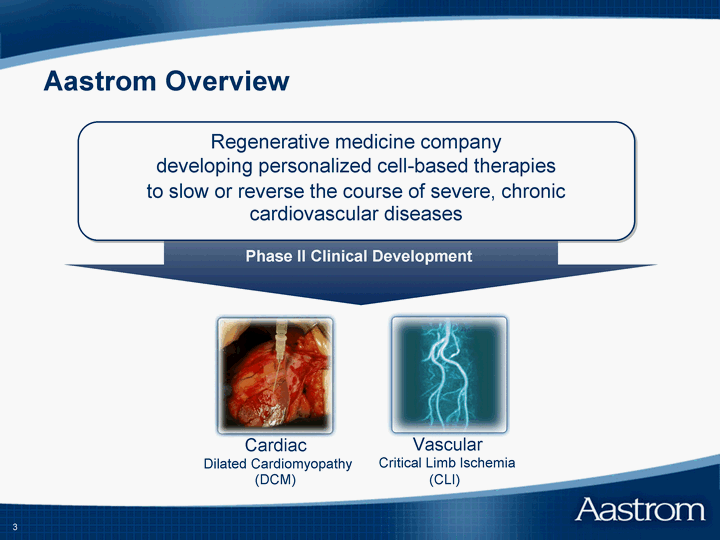
| 3 3 Aastrom Overview Cardiac Phase II Clinical Development Regenerative medicine company developing personalized cell-based therapies to slow or reverse the course of severe, chronic cardiovascular diseases Vascular Dilated Cardiomyopathy (DCM) Critical Limb Ischemia (CLI) |
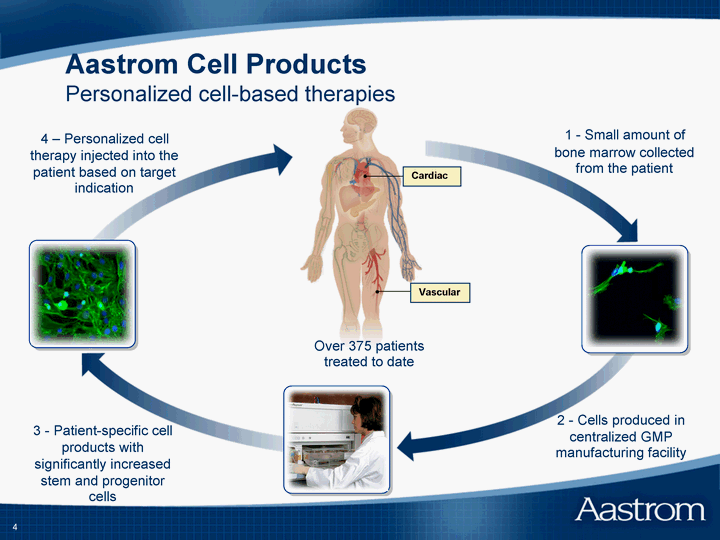
| 4 Aastrom Cell Products Personalized cell-based therapies 4 2 - Cells produced in centralized GMP manufacturing facility 3 - Patient-specific cell products with significantly increased stem and progenitor cells 4 - Personalized cell therapy injected into the patient based on target indication Cardiac Vascular Over 375 patients treated to date 1 - Small amount of bone marrow collected from the patient |
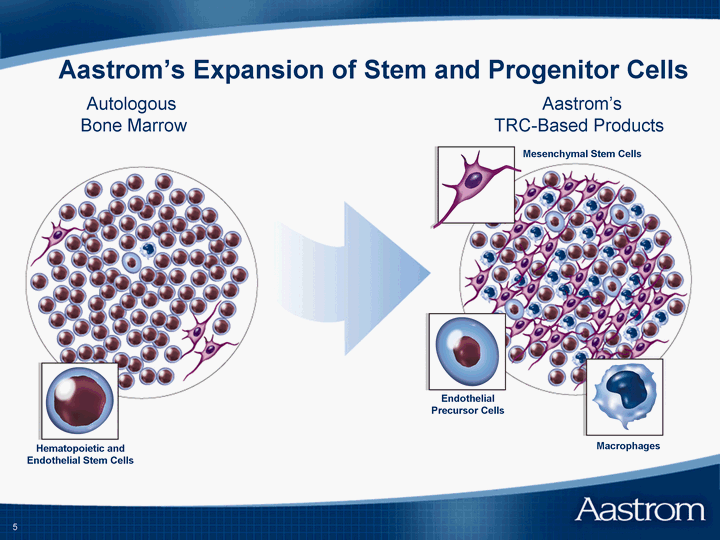
| 5 5 5 Hematopoietic and Endothelial Stem Cells Macrophages Autologous Bone Marrow Endothelial Precursor Cells Aastrom's TRC-Based Products Mesenchymal Stem Cells Aastrom's Expansion of Stem and Progenitor Cells |
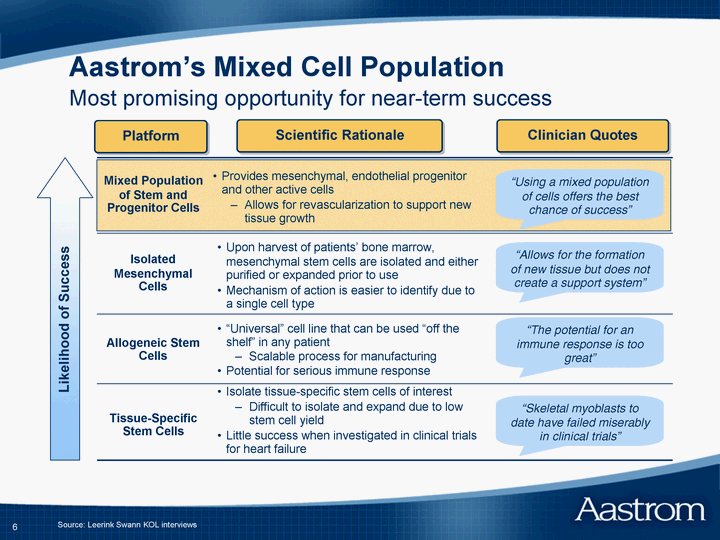
| 6 Aastrom's Mixed Cell Population Most promising opportunity for near-term success Source: Leerink Swann KOL interviews Tissue-Specific Stem Cells "Skeletal myoblasts to date have failed miserably in clinical trials" Isolate tissue-specific stem cells of interest Difficult to isolate and expand due to low stem cell yield Little success when investigated in clinical trials for heart failure Allogeneic Stem Cells "The potential for an immune response is too great" "Universal" cell line that can be used "off the shelf" in any patient Scalable process for manufacturing Potential for serious immune response Isolated Mesenchymal Cells "Allows for the formation of new tissue but does not create a support system" Upon harvest of patients' bone marrow, mesenchymal stem cells are isolated and either purified or expanded prior to use Mechanism of action is easier to identify due to a single cell type Mixed Population of Stem and Progenitor Cells "Using a mixed population of cells offers the best chance of success" Provides mesenchymal, endothelial progenitor and other active cells Allows for revascularization to support new tissue growth Likelihood of Success Scientific Rationale Platform Clinician Quotes |
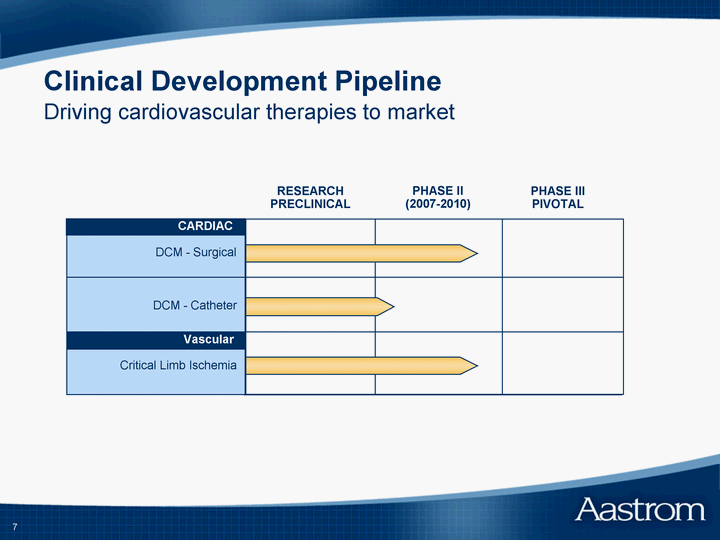
| 7 7 Clinical Development Pipeline Driving cardiovascular therapies to market RESEARCH PRECLINICAL PHASE II (2007-2010) PHASE III PIVOTAL Critical Limb Ischemia DCM - Catheter CARDIAC DCM - Surgical Vascular |
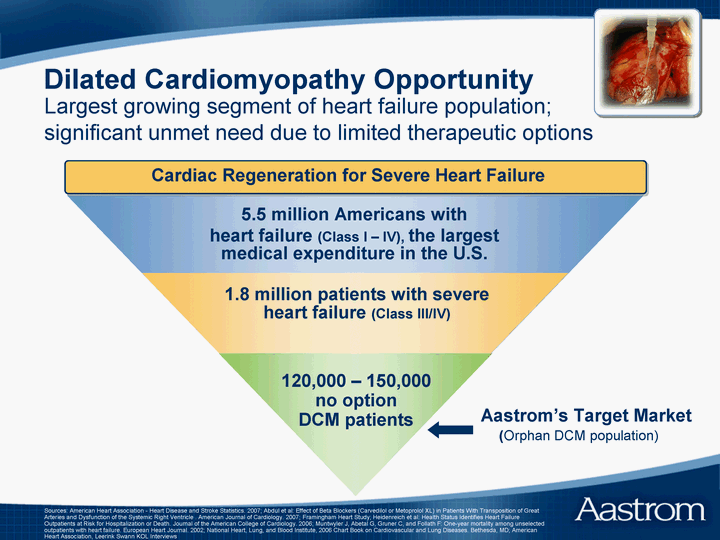
| Dilated Cardiomyopathy Opportunity Largest growing segment of heart failure population; significant unmet need due to limited therapeutic options 8 8 Cardiac Regeneration for Severe Heart Failure 5.5 million Americans with heart failure (Class I - IV), the largest medical expenditure in the U.S. 120,000 - 150,000 no option DCM patients Aastrom's Target Market (Orphan DCM population) Sources: American Heart Association - Heart Disease and Stroke Statistics. 2007; Abdul et al: Effect of Beta Blockers (Carvedilol or Metoprolol XL) in Patients With Transposition of Great Arteries and Dysfunction of the Systemic Right Ventricle . American Journal of Cardiology. 2007; Framingham Heart Study; Heidenreich et al: Health Status Identifies Heart Failure Outpatients at Risk for Hospitalization or Death. Journal of the American College of Cardiology. 2006; Muntwyler J, Abetal G, Gruner C, and Follath F: One-year mortality among unselected outpatients with heart failure. European Heart Journal. 2002; National Heart, Lung, and Blood Institute, 2006 Chart Book on Cardiovascular and Lung Diseases. Bethesda, MD; American Heart Association, Leerink Swann KOL Interviews 1.8 million patients with severe heart failure (Class III/IV) |
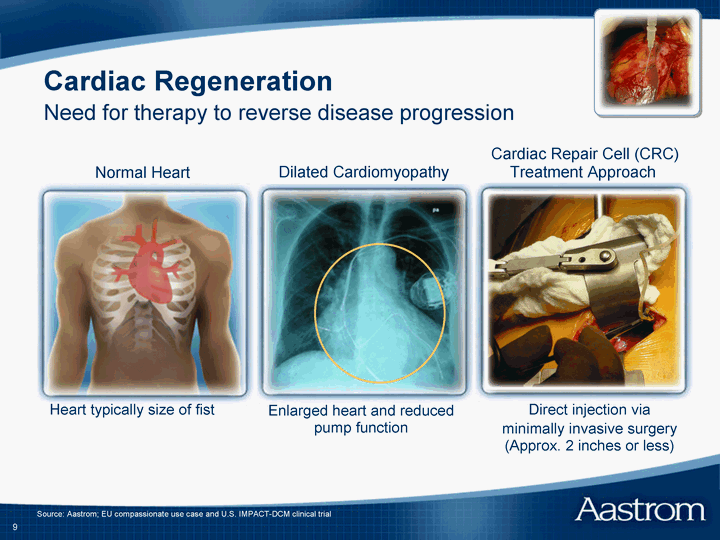
| 9 9 Cardiac Regeneration Need for therapy to reverse disease progression Source: Aastrom; EU compassionate use case and U.S. IMPACT-DCM clinical trial Normal Heart Cardiac Repair Cell (CRC) Treatment Approach Dilated Cardiomyopathy Heart typically size of fist Enlarged heart and reduced pump function Direct injection via minimally invasive surgery (Approx. 2 inches or less) |
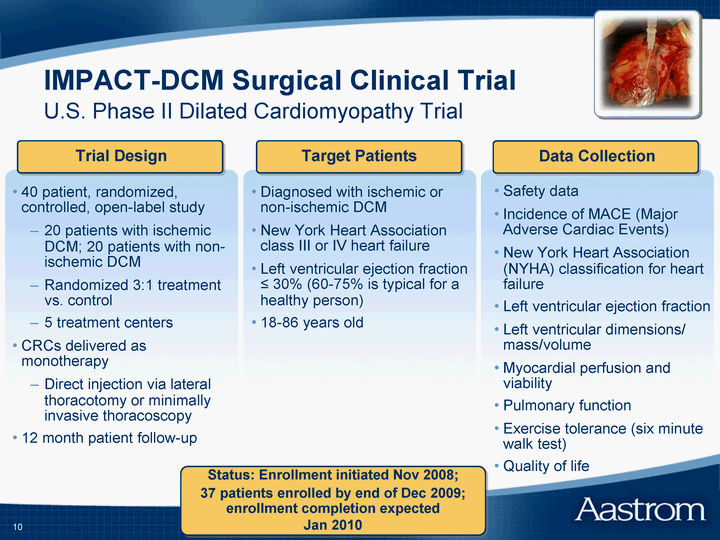
| Status: Enrollment initiated Nov 2008; 37 patients enrolled by end of Dec 2009; enrollment completion expected Jan 2010 10 10 IMPACT-DCM Surgical Clinical Trial U.S. Phase II Dilated Cardiomyopathy Trial 40 patient, randomized, controlled, open-label study 20 patients with ischemic DCM; 20 patients with non- ischemic DCM Randomized 3:1 treatment vs. control 5 treatment centers CRCs delivered as monotherapy Direct injection via lateral thoracotomy or minimally invasive thoracoscopy 12 month patient follow-up Target Patients Trial Design Safety data Incidence of MACE (Major Adverse Cardiac Events) New York Heart Association (NYHA) classification for heart failure Left ventricular ejection fraction Left ventricular dimensions/ mass/volume Myocardial perfusion and viability Pulmonary function Exercise tolerance (six minute walk test) Quality of life Data Collection Diagnosed with ischemic or non-ischemic DCM New York Heart Association class III or IV heart failure Left ventricular ejection fraction ^ 30% (60-75% is typical for a healthy person) 18-86 years old |
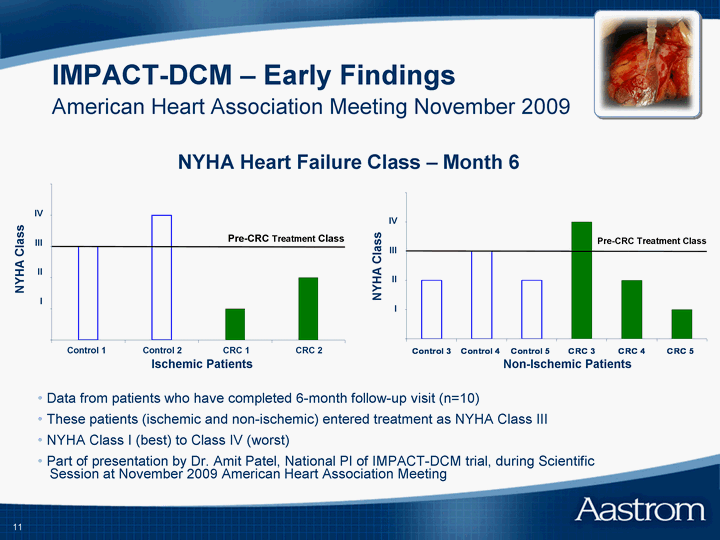
| 11 IMPACT-DCM - Early Findings American Heart Association Meeting November 2009 Data from patients who have completed 6-month follow-up visit (n=10) These patients (ischemic and non-ischemic) entered treatment as NYHA Class III NYHA Class I (best) to Class IV (worst) Part of presentation by Dr. Amit Patel, National PI of IMPACT-DCM trial, during Scientific Session at November 2009 American Heart Association Meeting I II III IV NYHA Class Ischemic Patients NYHA Heart Failure Class - Month 6 Pre-CRC Treatment Class I II III IV NYHA Class Non-Ischemic Patients Pre-CRC Treatment Class Control 1 Control 2 CRC 1 CRC 2 |
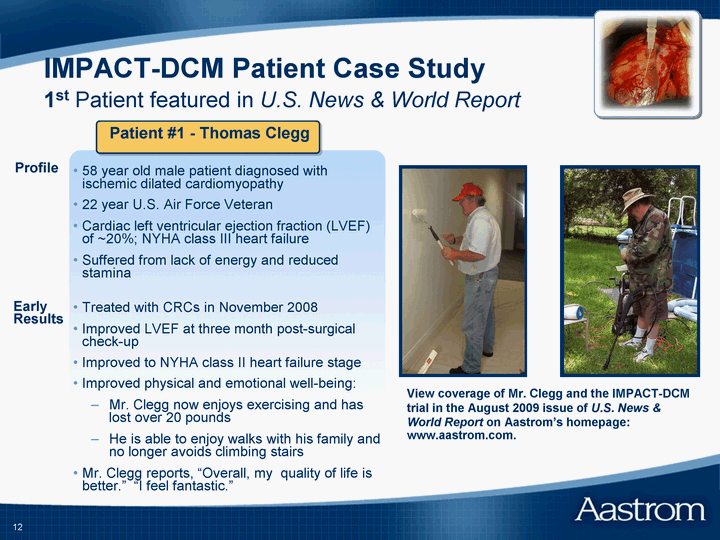
| 12 12 58 year old male patient diagnosed with ischemic dilated cardiomyopathy 22 year U.S. Air Force Veteran Cardiac left ventricular ejection fraction (LVEF) of ~20%; NYHA class III heart failure Suffered from lack of energy and reduced stamina Profile Patient #1 - Thomas Clegg Treated with CRCs in November 2008 Improved LVEF at three month post-surgical check-up Improved to NYHA class II heart failure stage Improved physical and emotional well-being: Mr. Clegg now enjoys exercising and has lost over 20 pounds He is able to enjoy walks with his family and no longer avoids climbing stairs Mr. Clegg reports, "Overall, my quality of life is better." "I feel fantastic." Early Results View coverage of Mr. Clegg and the IMPACT-DCM trial in the August 2009 issue of U.S. News & World Report on Aastrom's homepage: www.aastrom.com. IMPACT-DCM Patient Case Study 1st Patient featured in U.S. News & World Report |
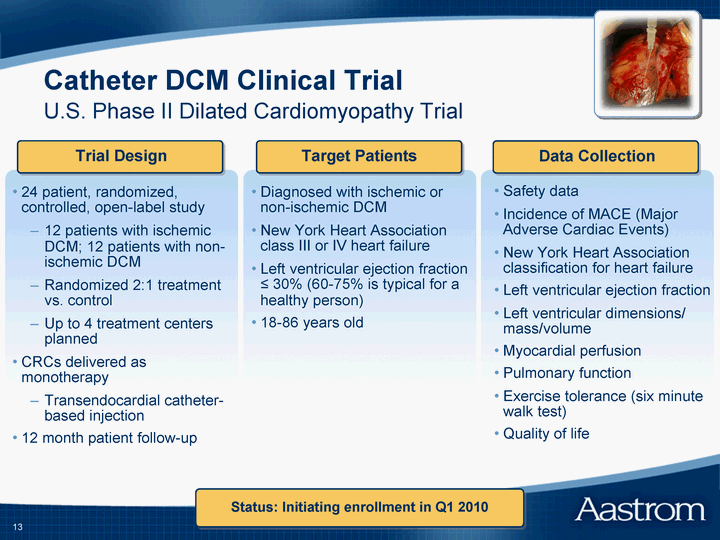
| 13 13 Catheter DCM Clinical Trial U.S. Phase II Dilated Cardiomyopathy Trial 24 patient, randomized, controlled, open-label study 12 patients with ischemic DCM; 12 patients with non- ischemic DCM Randomized 2:1 treatment vs. control Up to 4 treatment centers planned CRCs delivered as monotherapy Transendocardial catheter- based injection 12 month patient follow-up Target Patients Trial Design Safety data Incidence of MACE (Major Adverse Cardiac Events) New York Heart Association classification for heart failure Left ventricular ejection fraction Left ventricular dimensions/ mass/volume Myocardial perfusion Pulmonary function Exercise tolerance (six minute walk test) Quality of life Data Collection Diagnosed with ischemic or non-ischemic DCM New York Heart Association class III or IV heart failure Left ventricular ejection fraction ^ 30% (60-75% is typical for a healthy person) 18-86 years old Status: Initiating enrollment in Q1 2010 |
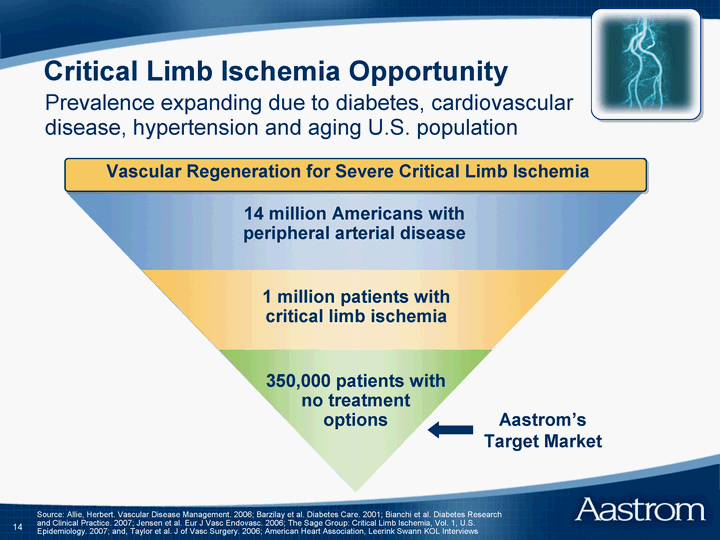
| 14 14 Critical Limb Ischemia Opportunity Vascular Regeneration for Severe Critical Limb Ischemia Source: Allie, Herbert. Vascular Disease Management. 2006; Barzilay et al. Diabetes Care. 2001; Bianchi et al. Diabetes Research and Clinical Practice. 2007; Jensen et al. Eur J Vasc Endovasc. 2006; The Sage Group: Critical Limb Ischemia, Vol. 1, U.S. Epidemiology. 2007; and, Taylor et al. J of Vasc Surgery. 2006; American Heart Association, Leerink Swann KOL Interviews 14 million Americans with peripheral arterial disease 1 million patients with critical limb ischemia 350,000 patients with no treatment options Aastrom's Target Market Prevalence expanding due to diabetes, cardiovascular disease, hypertension and aging U.S. population |
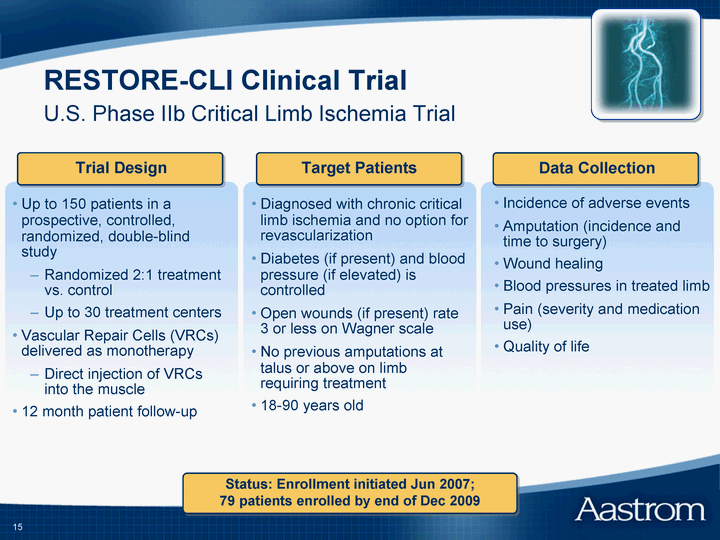
| 15 RESTORE-CLI Clinical Trial U.S. Phase IIb Critical Limb Ischemia Trial Up to 150 patients in a prospective, controlled, randomized, double-blind study Randomized 2:1 treatment vs. control Up to 30 treatment centers Vascular Repair Cells (VRCs) delivered as monotherapy Direct injection of VRCs into the muscle 12 month patient follow-up Target Patients Trial Design Incidence of adverse events Amputation (incidence and time to surgery) Wound healing Blood pressures in treated limb Pain (severity and medication use) Quality of life Data Collection Diagnosed with chronic critical limb ischemia and no option for revascularization Diabetes (if present) and blood pressure (if elevated) is controlled Open wounds (if present) rate 3 or less on Wagner scale No previous amputations at talus or above on limb requiring treatment 18-90 years old Status: Enrollment initiated Jun 2007; 79 patients enrolled by end of Dec 2009 |
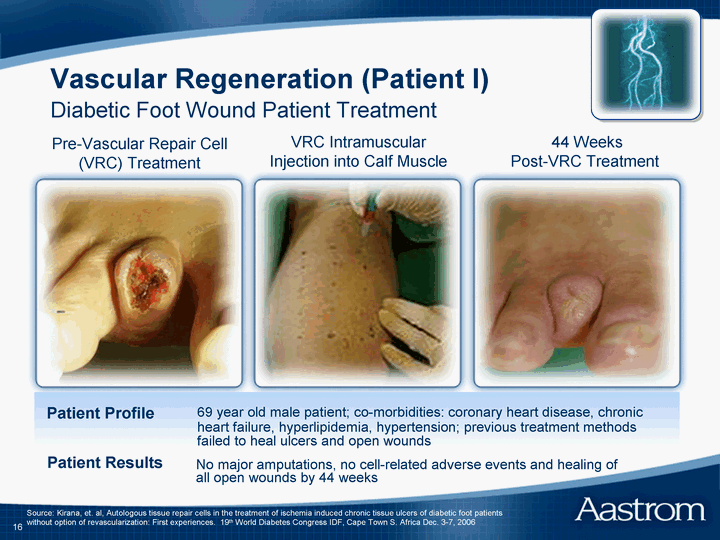
| 16 Patient Profile Pre-Vascular Repair Cell (VRC) Treatment 44 Weeks Post-VRC Treatment VRC Intramuscular Injection into Calf Muscle 69 year old male patient; co-morbidities: coronary heart disease, chronic heart failure, hyperlipidemia, hypertension; previous treatment methods failed to heal ulcers and open wounds Source: Kirana, et. al, Autologous tissue repair cells in the treatment of ischemia induced chronic tissue ulcers of diabetic foot patients without option of revascularization: First experiences. 19th World Diabetes Congress IDF, Cape Town S. Africa Dec. 3-7, 2006 Vascular Regeneration (Patient I) Diabetic Foot Wound Patient Treatment No major amputations, no cell-related adverse events and healing of all open wounds by 44 weeks Patient Results |
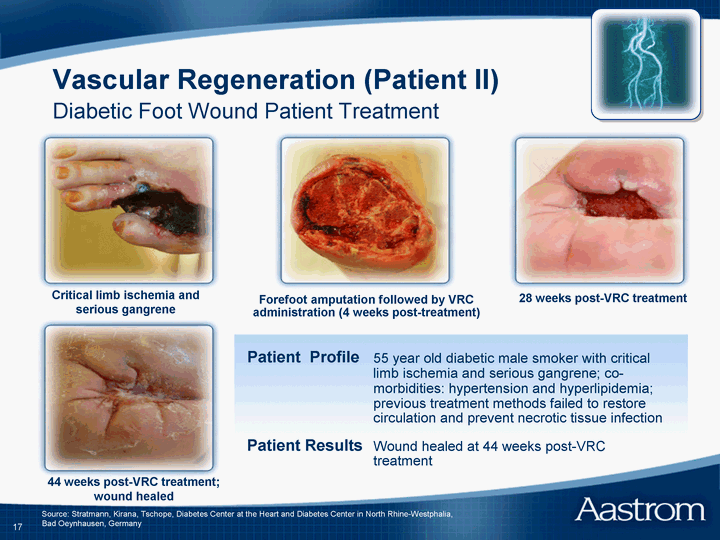
| 17 Vascular Regeneration (Patient II) Diabetic Foot Wound Patient Treatment Source: Stratmann, Kirana, Tschope, Diabetes Center at the Heart and Diabetes Center in North Rhine-Westphalia, Bad Oeynhausen, Germany Critical limb ischemia and serious gangrene Forefoot amputation followed by VRC administration (4 weeks post-treatment) 44 weeks post-VRC treatment; wound healed Patient Profile 55 year old diabetic male smoker with critical limb ischemia and serious gangrene; co- morbidities: hypertension and hyperlipidemia; previous treatment methods failed to restore circulation and prevent necrotic tissue infection 28 weeks post-VRC treatment Patient Results Wound healed at 44 weeks post-VRC treatment |
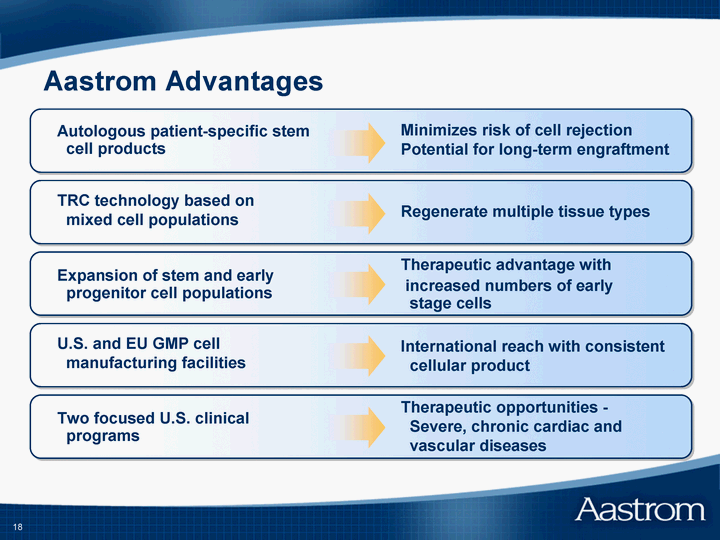
| 18 Minimizes risk of cell rejection Potential for long-term engraftment TRC technology based on mixed cell populations Regenerate multiple tissue types Expansion of stem and early progenitor cell populations Therapeutic advantage with increased numbers of early stage cells U.S. and EU GMP cell manufacturing facilities International reach with consistent cellular product Two focused U.S. clinical programs Therapeutic opportunities - Severe, chronic cardiac and vascular diseases Aastrom Advantages Autologous patient-specific stem cell products |
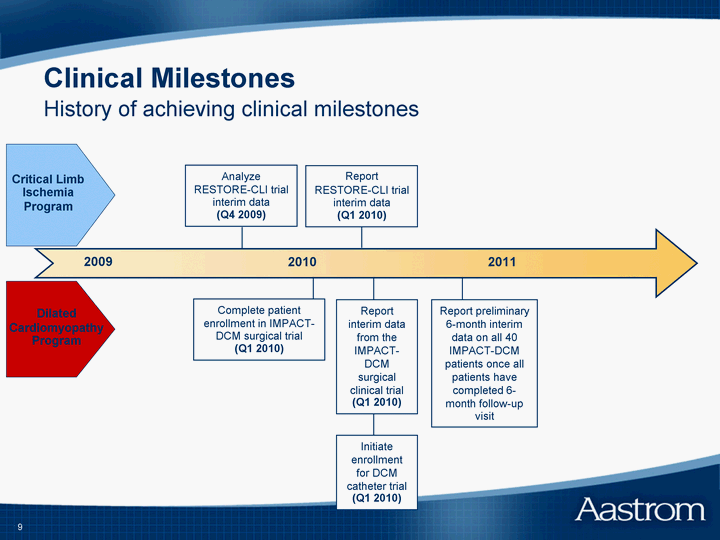
| 19 Clinical Milestones History of achieving clinical milestones 2009 Report preliminary 6-month interim data on all 40 IMPACT-DCM patients once all patients have completed 6- month follow-up visit Report RESTORE-CLI trial interim data (Q1 2010) 2010 Report interim data from the IMPACT- DCM surgical clinical trial (Q1 2010) 1 Complete patient enrollment in IMPACT- DCM surgical trial (Q1 2010) 2011 Initiate enrollment for DCM catheter trial (Q1 2010) Critical Limb Ischemia Program Dilated Cardiomyopathy Program Analyze RESTORE-CLI trial interim data (Q4 2009) |

| Nasdaq:ASTM Developing Regenerative Medicine Therapies to Treat Severe Cardiovascular Diseases 1/10-IR-V2 |
